Bringing the Climate Crisis Home
As is shown by extreme weather events that have affected nearly every corner of our world, the climate crisis is coming closer to all of us. The evidence is plenty: unimaginable heat records are being set across the northern hemisphere, droughts are creating...




